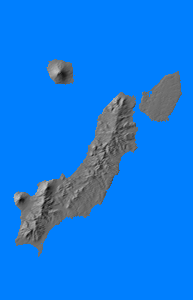![]() The Pacific War Online Encyclopedia
The Pacific War Online Encyclopedia
|
| Previous: Parafrag Bombs | Table of Contents | Next: Paratroops |

|  U.S. Army? Via photoship.co.uk |
Paramushiro (156.130E 50.660N) is located near the northernmost end of the Kurile Islands chain and was developed by the Japanese into a significant air and naval base. It was strategically located both for operations against Siberia and against the Aleutians and was raided by U.S. aircraft, submarines, and surface forces several times during the war.
Paramushiro has an area of 1000 square miles (2600 km2) and is mountainous, with a maximum elevation of 5,956' (1816 m). The nearby island of Shumshir (156.34E
50.73N) lies just a mile off the northeast tip of Paramushiro. It is
19 miles (30 km) long and 12 miles (20 km) wide, with an area of
190 square miles (500 km2). It is the lowest island in the
Kuriles, but it is crossed by a number of gulleys and ravines, and the
coast is generally backed by high (600' or 200 m) cliffs except at
Kataoka Bay (156.186E 50.716N).
Kimikawa Maru with 8 E13A Jakes was present on 7
December 1941.
The first air raid against Paramushiro took place on 18 July 1943, from the newly developed airfield on Attu. The Americans achieved nearly complete surprise and escaped with small losses. Later raids were heavily opposed and soon became too costly for the Americans to continue.
Paramushiro and Shumshir had six airstrips, with capacity
for 600 aircraft, by August
1945. There were two runways at Kataoka and a single runway near the
center of Shimushu. However, there were few aircraft left in the islands
by that
time. Naval bases had been constructed at Kataoka Bay on Shimushu and
Kasivabara (156.140E 50.673N) on Paramushiro. The garrison was built around 91 Division, with 73 Brigade and 11 Tank Regiment on Shumshir and 74 Brigade on Paramushiro. There was considerable artillery support from Kuril Fortress Artillery Regiment. Total forces Shumshir were six battalions (8480 men) with 60 tanks, 98 guns and mortars, and 275 machine guns, concentrated in the Kataoka area, while total forces on Paramushiro were four battalions, 17 tanks, 79 guns and mortars, and 152 machine guns. Both island were heavily fortified, with 34 reinforced concrete and 24 earth and timber pillboxes on Shumshir and 13 reinforced concrete and 44 earth and timber pillboxes on Paramushiro.
The two islands were seized by the Russians
following the announcement of the Japanese surrender.
The island garrison was expecting landings by American occupation
forces and were surprised by the arrival of the Russian forces, built
around 101 Rifle Division with supporting elements and air cover and
transported by 14 transports and 4 trawlers escorted by about 20 escort vessels of various types. These arrived in the early hours of 18 August 1945
and began their landings before the Japanese could decide whether to
open fire. By dawn a pitched battle was taking place. The Russians
called on the Japanese to surrender
late on 19 August and the Japanese agreed to cease resistance, but
fighting flared back up the next morning, with each side blaming the
other for breaking the ceasefire. A second ceasefire went into effect
early on 21 August, and the Japanese troops were disarmed by the end of
23 August 1945.
References
The Pacific War Online Encyclopedia © 2007, 2010, 2012 by Kent G. Budge. Index